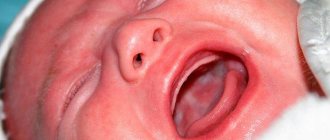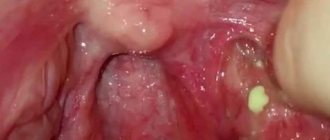From this article you will learn:
- what do white spots on gums mean?
- why does a white coating appear on the mucous membrane,
- what to do if your gums turn white.
The article was written by a dentist with more than 19 years of experience.
A white spot on the gum is a symptom of diseases of the oral mucosa, which is most often characteristic of a disease such as leukoplakia. And this is not such a harmless disease (as it may seem at first glance), but it has its consequences and requires certain therapy. According to the International Classification of Diseases, leukoplakia is classified as a precancerous disease of the oral cavity, i.e. in some cases, mucosal lesions can become malignant.
But there is a similar variant of damage to the oral mucosa, in which a white coating may appear on the gums, tongue, mucous membrane of the cheeks and palate. In some cases it can be easily scraped off, but in later stages of the disease it is usually firmly attached to the mucosal surface. The appearance of such white plaque on the gums, tongue and other parts of the oral mucosa indicates the development of oral candidiasis.
An overview of the most common factors leading to the appearance of white plaque and stains on the gums
Normally, white plaque does not form on the gums, of course. However, with such a symptom, there is no need to immediately panic, because it can also indicate completely harmless phenomena, of which there are quite a few. First, you need to carefully examine the film formed on the mucous membrane, pay attention to the accompanying symptoms, and then draw certain conclusions.
Reasons why gums turn white
Sometimes plaque is just a reason to improve your oral hygiene
If you notice a white coating on your gums, especially in the morning, this may indicate a lack of good oral hygiene. Remember that a lot of bacteria live in your mouth, and if you haven’t brushed your teeth well or even skipped a mandatory daily ritual, then food remains remain there. All together leads to the formation of a microbial film, which grows especially actively at night, when very little saliva is produced in the mouth.
Typically, white plaque on the teeth near the gums, as well as on the tongue, which is detected in the morning, can be easily removed with a brush, paste, or rinse. But if you do not pay due attention to morning and evening hygiene procedures, the deposits will mineralize, that is, they will become hard. It is no longer possible to clean these at home. It is necessary to go to the dentist for professional hygiene, otherwise there is a risk of getting inflammatory processes on the mucous membrane, gingivitis, periodontitis, caries.
Relatively safe causes that cause a problem in an adult
As noted above, if a white coating has formed on the gum, this is not always a reason to panic. Sometimes this is a consequence of procedures such as teeth whitening, the use of rinses with an antiseptic effect, or surgical intervention in the oral cavity (for example, tooth extraction and implantation, plastic surgery).
Major appearance of white gums
True, there is a very thin line here that separates normality from pathology. After all, white formations on the mucous membrane can be both a sign of natural tissue healing (a film of white fibrin forms on them, which is called “fibrinous plaque”), and a symptom indicating the addition of an infection or the occurrence of complications. This may indicate poorly performed procedures or the patient’s violation of the recommendations given by the doctor.
Expert opinion
Elina Ruslanovna Dzagurova
Specializations: Dentist-therapist
Experience: 11+
“Mouth rinses with antiseptics should not be used for longer than 10-14 days. This can cause irritation, dry tissue, disrupt normal microflora, and lead to the development of candidiasis. As for professional and home whitening procedures, gums can also turn white due to tissue burns. But in any case, pathological conditions are not limited to just a change in the color of the mucous membrane, they are accompanied by pain, an increase in alarming symptoms, and swelling of the gums.”
The problem can be caused by an allergy to food, hygiene products, or medicinal compounds used in dentistry for dental treatment.
Important! If you have recently had your teeth whitened, used a mouthwash, or had any treatment or surgery in your mouth, monitor your condition closely. Normally, disturbing symptoms subside with each subsequent day, but with pathology they worsen, reappear, and are accompanied by a general deterioration in health, severe pain, swelling and bleeding of tissues, increased body temperature, and the formation of ulcers.
Can stomatitis go away on its own?
Patients often delay visiting a doctor, hoping that stomatitis will go away on its own. Stomatitis in non-advanced forms can actually go away on its own within a week. But given the risk of complications and, as a rule, a fairly high degree of discomfort from which the patient suffers with this disease, it is much wiser to seek help from a doctor and receive competent medical care.
Correctly prescribed treatment, following the recommendations of the attending physician, will bring rapid relief and improved quality of life. In addition, this will speed up the process of curing stomatitis, avoid the unpleasant consequences of untimely treatment, and also, thanks to diagnostics, learn about the causes of stomatitis and, if necessary, take care of your health. It is difficult for a patient who does not have special knowledge to assess the severity of his disease and the causes that caused it, so seeking medical help is necessary.
Possible consequences and complications of stomatitis
Recurrent stomatitis can be cured quickly if you follow your doctor’s recommendations. But sometimes patients may experience some complications:
- lung diseases;
- damage to the entire mucosa;
- digestive problems;
- loss of some teeth.
Typically, such complications are the result of self-medication or lack of treatment, which is why you should consult a doctor in a timely manner.
Dental problems and complications
Periodontal disease
This disease cannot be completely attributed to dental disease, since it can be provoked not only by advanced or long-term and unsuccessfully treated periodontitis, but also by internal pathologies of the body and metabolic disorders. However, the result is obvious: pale whitish gums without signs of bleeding, recession, exposure of the roots of the teeth, increased sensitivity and mobility of the dentition.
Development of periodontal disease
What is the difference between periodontitis and periodontal disease? Read here.
2. Advanced caries, pulpitis, periodontitis, periostitis
If such diseases are not treated for a long time, they are complicated by the appearance of a white spot, pimple or fistula (abscess, abscess) on the gum. This may be a sign of a cyst, granuloma, abscess, phlegmon and even osteomyelitis. Usually accompanied by severe pain. The tumor may burst, which brings relief, but this is not a reason to postpone a visit to the doctor.
Poor quality treatment
There are situations when white plaque on the gums and an abscess have formed after tooth treatment. At the same time, there is a filling or even a crown on it. In this case, the symptom may indicate poor-quality treatment, incomplete sealing of the root canals, or incorrectly manufactured and installed orthopedic construction. For example, the presence of a crown that does not correspond to the individual characteristics of the patient can lead to overload of periodontal tissues, the development of traumatic periodontitis, and, as a consequence, the formation of an abscess on the mucous membrane next to the causative tooth.
On a note! Inconvenient, poorly made, or not corrected for a long time, removable dentures often rub the gums and interfere with blood circulation in them, which leads to blue mucous membranes or the appearance of white areas on them, and can also provoke denture stomatitis.
Allergy to materials
Some patients complain that their gums become swollen and white after dental treatment. This may be a sign of the body’s individual reaction to the medications and materials used, which may also be of poor quality. This symptom is accompanied by others: the appearance of blisters and rashes, redness and itching of the mucous membrane.
5. Complications after surgery
Thus, white plaque in the gums after tooth extraction may indicate the development of an infectious and inflammatory process such as alveolitis. Pathology occurs if the socket of the removed unit is “dry”, that is, a protective blood clot does not form in it, or it is destroyed prematurely, and bacteria and food debris penetrate inside.
Complications after surgery
“I had a tooth removed for the first time in my life, and 3 days later a white coating appeared on my gums. I was very scared when I saw it. I tried to clean it carefully with a cotton swab. As it turned out later, it was in vain. I removed this film and calmed down, but a few days later severe lumbago and pain began in the area of the wound, a rotten smell came from my mouth, and pus began to ooze. I had to run to the doctor, who scolded me during the appointment. I was treated for 2 weeks. In fact, I myself became the culprit of this problem.”
Valensia, review from gidpozubam.ru
After dental implantation, during the tissue healing stage and before the sutures are removed, the gums may also be white, which is normal. But if a symptom occurs several months or even years after treatment, it may indicate the development of mucositis and peri-implantitis.
Average cost of treatment in Moscow
| Name of service | Cost, rub. |
| Dentist consultation | 600 |
| Periodontist consultation | 740 |
| Consultation with an implantologist | 820 |
| Treatment of complications | |
| Removing dental plaque in the area of 1 tooth | 180 |
| Periodontal applications in the area of 1 tooth | 370 |
| Application of a protective periodontal bandage | 400 |
| Closed curettage of periodontal pockets | 900 |
| Open curettage of pockets | 1300 |
| Flap surgery | 3000 |
| Implant removal | 6900 |
| Implantation of osteoconductive material in the area of 1 tooth | 10900 |
| Implantation of a protective membrane (1 tooth) | 12900 |
Common pathological conditions
Let us list in which cases white plaque in the mouth and on the gums is a sign of a serious pathology that requires prompt consultation with a doctor:
- stomatitis: can occur against the background of reduced immunity, injuries, long-term use of medications, chronic diseases. White plaque on the gums is accompanied by severe pain in the affected areas, bad breath, and a general deterioration in health. It can be candidiasis, aphthous, herpetic, vesicular, allergic, traumatic, so its independent treatment is excluded,
- Leukoplakia: this is a precancerous disease in which keratinization of the oral mucosa occurs. Factors that provoke this pathology are often smoking, malocclusion, the presence of chipped fillings and decayed teeth (they constantly injure tissue), wearing ill-fitting dentures, galvanism,
- oncology and oral cancer itself,
- pathologies of the gastrointestinal tract: for example, gastritis,
- lichen planus,
- AIDS, syphilis[1].
Plaque as a sign of tissue burn
Various thermal and chemical factors can contribute to the appearance of white plaque on the mucous membrane. For example, drinking hot drinks and soups, smoking, using aggressive compounds (manganese, hydrogen peroxide, iodine, alcohol) in the oral cavity. As a rule, after a burn, the tissues first turn red, but after a while they become covered with a whitish film, which indicates the process of their healing and renewal of the epithelium.
Photo: chemical burn of gums
Prevention
Regular cleaning of the oral cavity in an office setting has a positive effect on dental health. When the gum mucosa is affected, you should not touch it with your hands, burn it with alcohol, or eat hot and spicy food. You should carefully observe the rules of hygiene and systematically care for your oral cavity. It is good if the patient can quit smoking and drinking alcoholic beverages. The intake of salty, spicy foods and spices should be reduced to a minimum. You need to use a separate towel and dishes. It is important not to miss visits to the dentist, visit the dentist 2 times every six months.
It is better to rinse after breakfast, lunch, and dinner. This helps maintain the oral microflora in order. The risk of pathology is reduced if you perform a special massage of the gums in a circular motion. This improves blood circulation. It is useful to walk in the fresh air, take walks in a park or square. Avoid stress, alternate rest with feasible physical activity.
Measures to help get rid of symptoms in different situations
Dynamic observation, careful care and diet correction
If white plaque appears on the gums, this does not mean that you need to immediately begin treating it. First you need to find out the reason why the symptom appeared. If it is on the surface, for example, insufficient hygiene, eating hot food and minor tissue burns, recent teeth whitening and treatment, then you need to look at the circumstances. Normally, just observation and the following actions are enough:
- treatment of the oral cavity with antiseptic solutions and herbal decoctions,
- careful daily hygiene,
- transition to a gentle diet with a predominance of soft and temperature-neutral food,
- giving up bad habits so as not to further irritate or injure tissues,
- If alarming symptoms intensify, severe pain, pus, or malaise appear, you should definitely consult a doctor.
Prosthetics and orthodontics
If the mucous membrane is injured by poorly fitting crowns and dentures, there are decayed teeth in the mouth, or an incorrect bite, you need to make an appointment with a dentist. It is important to eliminate the traumatic factor, because its constant exposure can easily provoke the same stomatitis, gingivitis, periodontitis, leukoplakia and oncology, one of the signs of which can be whitened oral tissues.
Dental treatment
If white plaque on the gums is caused by periodontitis, abscess, alveolitis and other dental diseases, then it is useless to find out what to rinse your mouth with to cure it. Antiseptics and decoctions of pharmaceutical herbs are used only in addition to the main treatment carried out by the doctor. If necessary, the specialist opens and cleans the root canals, fills and refills the teeth, removes and drains abscesses, and applies therapeutic bandages.
Gum treatment
Periodontal disease will require a long course of treatment and a whole range of measures: professional hygiene, curettage of gums, splinting of loose teeth, injections of vitamins and drugs with an effect stimulating the growth of own cells, plasma lifting, laser therapy. In advanced stages, it may be necessary to remove diseased teeth to completely get rid of the infection. Next, a thorough sanitation of the holes is carried out, one-stage implantation is immediately possible, as well as removable prosthetics.
Laser gum treatment surgery
5. Taking antihistamines and replacing dentures
If it's an allergic reaction, then you need to understand what caused it. Sometimes it is enough to simply exclude the allergen and take antihistamines for several days for any symptoms to go away. In case of allergies to prosthetic materials and galvanic syndrome, there can be only one way out - replacing the structures with those consisting of materials biocompatible with the body (ceramics, zirconium dioxide, ceramic composite).
6. Antibacterial and antifungal therapy
If you suspect stomatitis, it is better to immediately consult a dentist, who, depending on the type of pathology, may prescribe anti-inflammatory, antibacterial and antifungal agents.
Diagnosis of stomatitis
Only a doctor can make a diagnosis. Typically, the doctor reviews the medical record and then examines the patient's mouth. Today, no special medical diagnostic methods, such as laboratory culture analysis or biopsy, are used to detect stomatitis, since they do not exist for this disease. In diagnosis, the doctor is guided by the main and main signs of stomatitis:
- This is the appearance of the ulcers and their location
- The condition of the oral tissues around the ulcers - with stomatitis they look normal and healthy
- The fact of recurrence of episodes of the disease
- The patient has no deterioration in general health, high temperature and other significant general symptoms. This symptom does not apply to advanced forms of stomatitis, mainly in children, when there are a large number of ulcers and just a high temperature and poor health. The diagnosis of stomatitis can only be made by a doctor.










